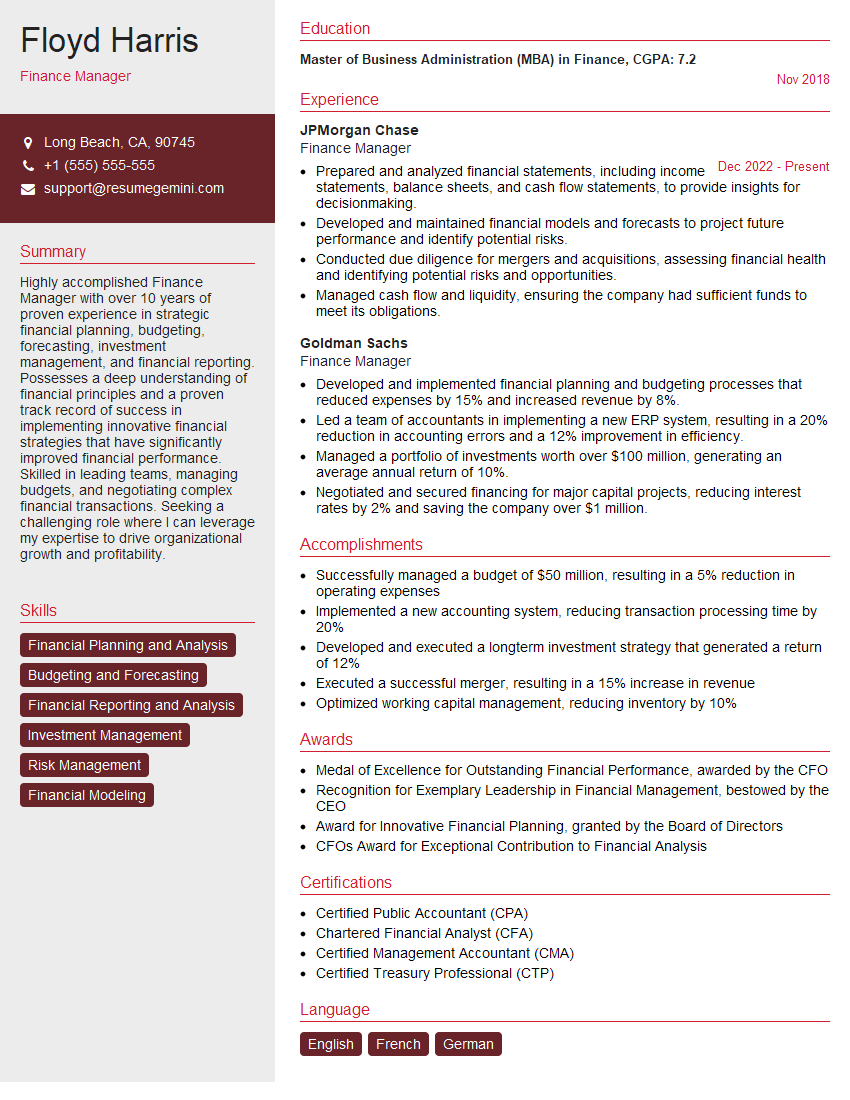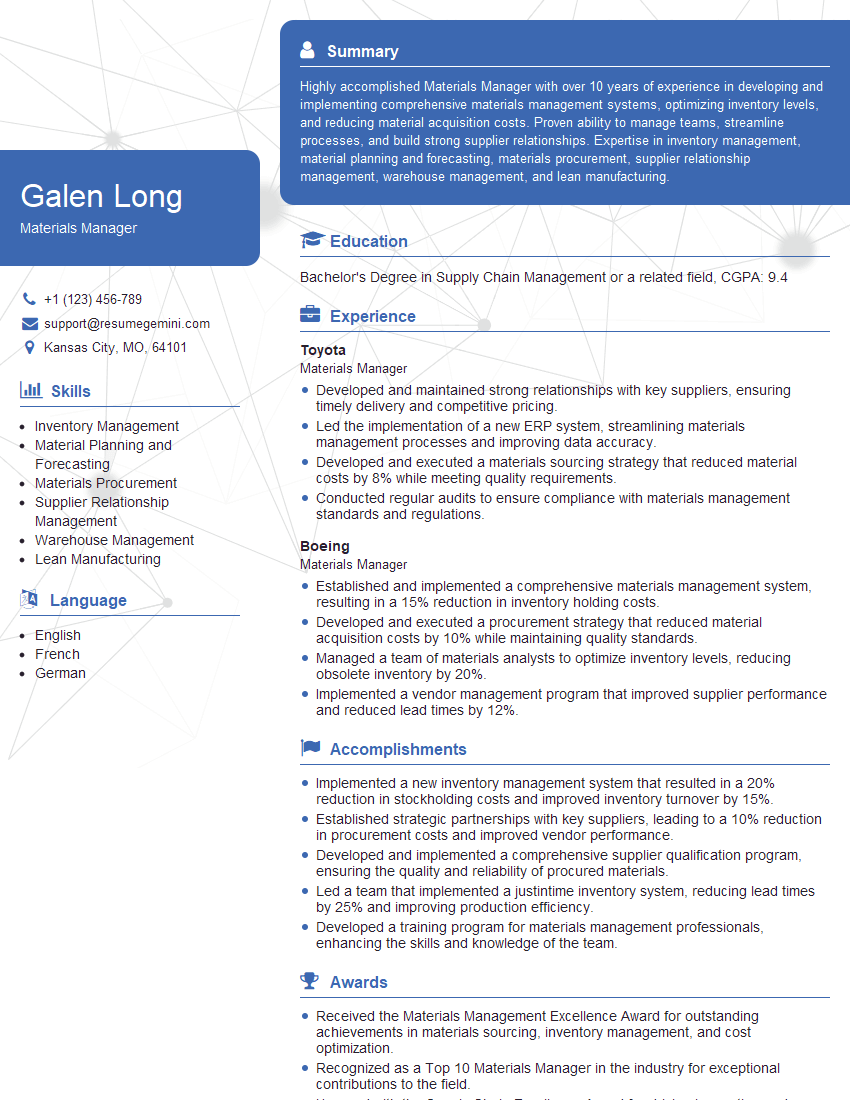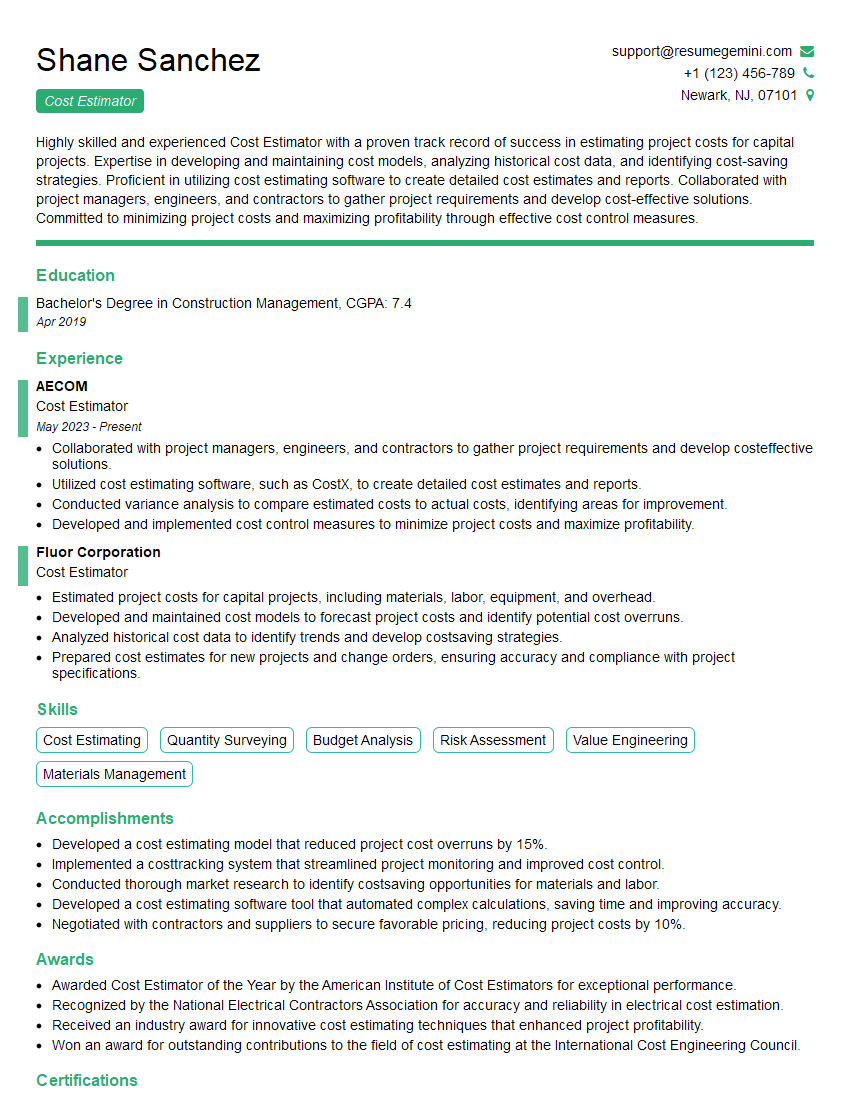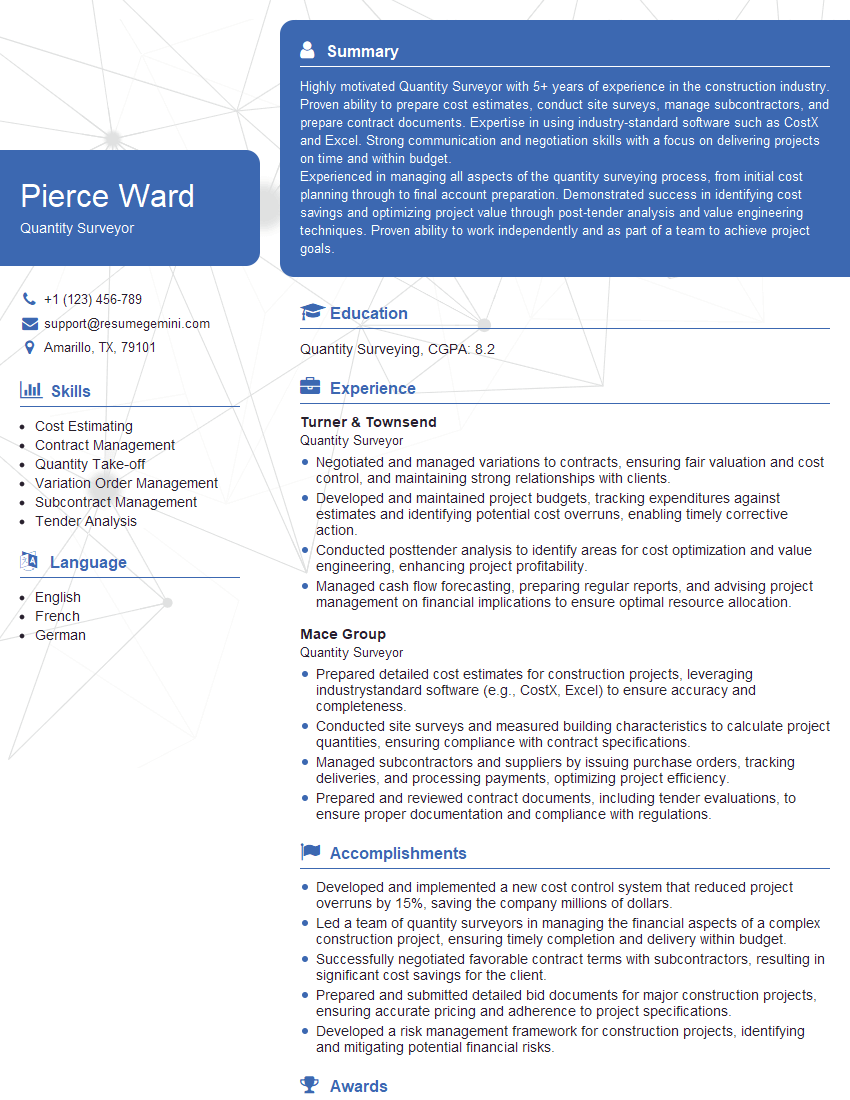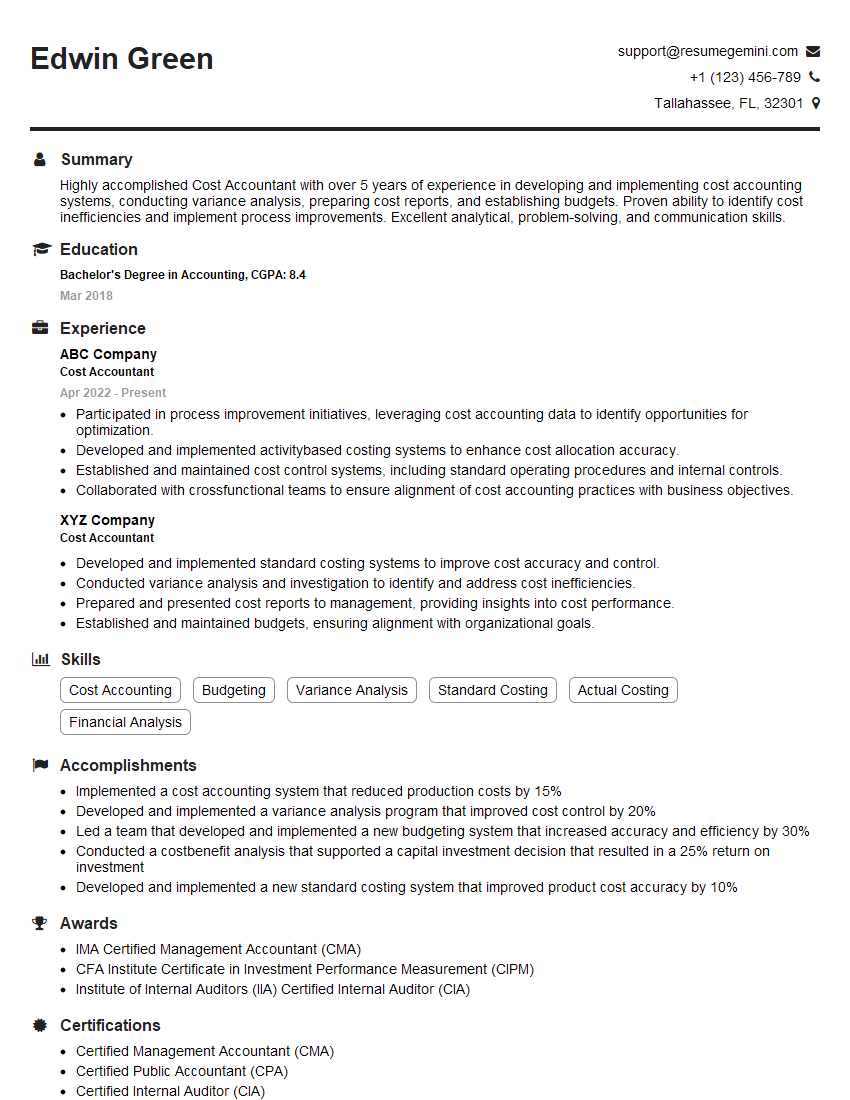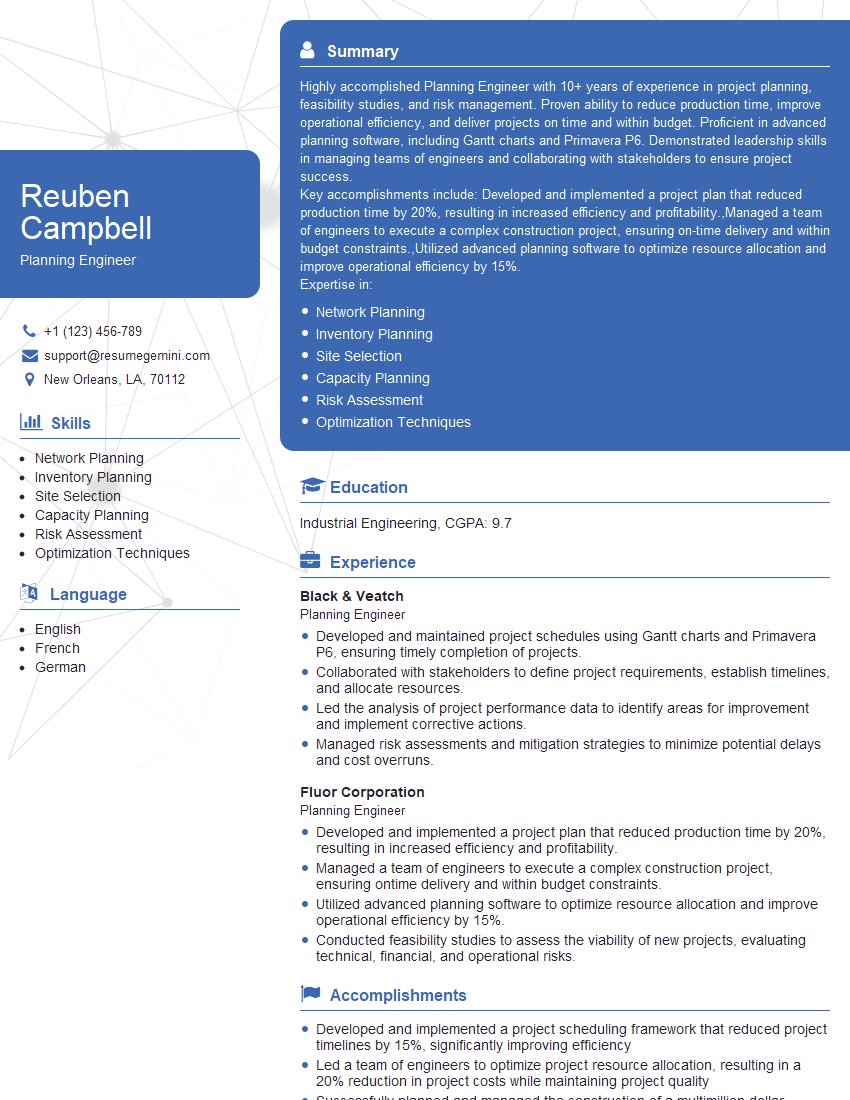Cracking a skill-specific interview, like one for Budgeted Labor and Material Costs, requires understanding the nuances of the role. In this blog, we present the questions you’re most likely to encounter, along with insights into how to answer them effectively. Let’s ensure you’re ready to make a strong impression.
Questions Asked in Budgeted Labor and Material Costs Interview
Q 1. Explain the difference between direct and indirect labor costs.
The key difference between direct and indirect labor costs lies in their traceability to a specific project or product. Direct labor costs are those easily and directly attributable to the creation of a product or service. Think of the wages paid to a carpenter building a house or a software developer writing code for a specific application. These costs are easily assigned and tracked. In contrast, indirect labor costs are those that support the production process but aren’t directly tied to a single project. This includes salaries of administrative staff, maintenance personnel, or cleaning crews. These costs are often allocated across multiple projects based on a predetermined method, like the number of labor hours utilized by each project.
Example: Imagine building a custom cabinet. The wages of the carpenter directly working on the cabinet are direct labor costs. However, the salary of the factory manager overseeing several projects, including the cabinet, would be an indirect labor cost, usually allocated based on a predetermined percentage or a cost driver like machine hours.
Q 2. How do you calculate the total budgeted cost of a project?
Calculating the total budgeted cost of a project involves a systematic approach encompassing both material and labor costs, along with other project-related expenses. The basic formula is:
Total Budgeted Cost = Direct Material Costs + Direct Labor Costs + Indirect Material Costs + Indirect Labor Costs + Overhead Costs + Contingency
Let’s break this down:
- Direct Material Costs: The cost of materials directly used in the project (e.g., wood for a cabinet).
- Direct Labor Costs: Wages and benefits of individuals directly working on the project (e.g., carpenter’s wages).
- Indirect Material Costs: Costs of materials used to support the project but not directly incorporated (e.g., cleaning supplies for the workshop).
- Indirect Labor Costs: Salaries of support staff not directly working on the project (e.g., factory manager’s salary).
- Overhead Costs: General business expenses (e.g., rent, utilities).
- Contingency: A buffer for unforeseen expenses or delays (recommended: 5-10% of the total cost).
Accurate estimations for each component are critical for effective budgeting. This often involves historical data analysis, market research, and expert judgment.
Q 3. What are some common methods for estimating material costs?
Estimating material costs is crucial for accurate project budgeting. Several methods exist, each with its strengths and weaknesses:
- Detailed Quantity Takeoff: This involves meticulously listing every material needed and its corresponding cost, creating a highly precise estimate. It’s best suited for large or complex projects where accuracy is paramount but can be very time-consuming.
- Unit Cost Estimation: This method uses historical data or market prices to estimate the cost per unit of material (e.g., cost per square foot of lumber). It’s quicker than a detailed takeoff but depends on the reliability of the historical data and accurate quantity forecasting.
- Engineering Estimates: Used for complex projects, these rely on detailed engineering drawings and specifications to determine material quantities and associated costs. This method is precise but necessitates specialized engineering expertise.
- Parametric Estimation: Statistical models are developed using historical project data to estimate costs based on project parameters like size or complexity. This approach is effective when a large database of similar projects exists.
Choosing the appropriate method depends on project size, complexity, available data, and the required level of accuracy.
Q 4. Describe your experience with variance analysis in budgeting.
Variance analysis is a cornerstone of effective budgeting, allowing us to identify deviations between planned and actual costs. My experience involves systematically comparing budgeted costs against actual expenditures to pinpoint the sources of any discrepancies. This entails using various tools and techniques to understand the ‘why’ behind the variations.
I typically utilize both cost variance (the difference between budgeted and actual cost) and schedule variance (the difference between planned and actual progress). By analyzing both, we can determine if cost overruns are due to inefficient resource use or unexpected delays. For instance, a positive cost variance (overbudget) could be due to higher-than-anticipated material costs or longer-than-expected labor hours. A negative schedule variance (behind schedule) could lead to cost overruns even if individual task costs are on budget.
Thorough variance analysis allows for data-driven decision-making and corrective actions, preventing future cost overruns and improving future project estimations.
Q 5. How do you handle unforeseen cost overruns during a project?
Unforeseen cost overruns are an inevitable aspect of project management. My approach to handling them involves a structured process. First, I conduct a thorough investigation to determine the root cause of the overrun. Was it due to unforeseen circumstances like material price increases or inaccurate initial estimates? Or were there efficiency issues during project execution?
Once the cause is identified, I assess the impact on the overall project timeline and budget. I then collaborate with stakeholders to explore mitigation strategies. This might involve renegotiating contracts, adjusting the project scope (reducing features or eliminating less critical tasks), seeking additional funding, or optimizing resource allocation to compensate for the overrun.
Transparency with stakeholders is crucial throughout this process. Regular updates on the situation, along with clear explanations of the proposed solutions, help manage expectations and ensure everyone is on board.
Q 6. What software or tools are you proficient in for budgeting and cost control?
I’m proficient in several software and tools for budgeting and cost control, including:
- Microsoft Excel: For creating detailed budgets, tracking expenses, and performing variance analyses. I frequently use pivot tables and charts to visualize data effectively.
- Microsoft Project: For scheduling projects, assigning resources, and monitoring progress, which directly impacts cost management.
- Primavera P6: For managing larger, more complex projects, offering advanced scheduling and resource allocation capabilities.
- Costpoint: For integrated cost management within a larger ERP system, providing comprehensive financial reporting and analysis features.
My familiarity with these tools, combined with my understanding of best practices in cost management, allows me to deliver accurate budgets, effectively track expenses, and analyze variances to maintain project financial control.
Q 7. Explain your understanding of earned value management (EVM).
Earned Value Management (EVM) is a project management technique that integrates scope, schedule, and cost to provide a comprehensive assessment of project performance. It uses three key metrics:
- Planned Value (PV): The authorized budget assigned to scheduled work.
- Earned Value (EV): The value of work completed to date, based on the project’s schedule and budget.
- Actual Cost (AC): The actual cost incurred to complete the work performed.
EVM utilizes these metrics to calculate key performance indicators (KPIs) such as Schedule Variance (SV = EV – PV), Cost Variance (CV = EV – AC), and Schedule Performance Index (SPI = EV/PV), Cost Performance Index (CPI = EV/AC). These KPIs provide insights into project performance and help identify potential issues early on, allowing for proactive adjustments.
Example: If the PV for a task is $10,000, the EV is $8,000 (80% complete), and the AC is $9,000, the SV is -$2,000 (behind schedule), the CV is -$1,000 (over budget), SPI is 0.8, and CPI is 0.88. This shows the project is behind schedule and over budget.
EVM enables data-driven decision making, enhancing project control and accountability. It’s especially beneficial in large, complex, and/or high-risk projects.
Q 8. How do you account for inflation in your budget estimations?
Accurately forecasting budgeted labor and material costs requires anticipating inflation. Ignoring inflation leads to significant underestimation, jeopardizing project success. I employ several strategies to account for it.
Historical Data Analysis: I review past project data to identify historical inflation rates for labor and materials. This provides a baseline for future projections. For example, if the cost of lumber increased by 8% annually over the past three years, I would incorporate a similar inflation rate into my current estimates.
Industry Benchmarks: I consult industry reports and publications to understand predicted inflation rates for relevant sectors. This offers a broader perspective beyond our historical data, capturing external economic factors.
CPI and PPI Data: I utilize Consumer Price Index (CPI) and Producer Price Index (PPI) data to understand general inflation trends and specific inflation rates for materials. The CPI reflects consumer price changes, while the PPI focuses on the price changes at the producer level – extremely helpful for raw materials.
Contingency Buffer: Even with thorough analysis, unforeseen inflation can occur. Therefore, I build a contingency buffer into my budget, typically ranging from 5-10%, to absorb unexpected price increases.
By combining these methods, I develop a more robust and realistic budget that accounts for the impact of inflation.
Q 9. How do you identify and mitigate potential risks to the budget?
Risk identification and mitigation are critical for budget control. I use a proactive approach, employing several techniques.
Risk Assessment Matrix: I create a matrix identifying potential risks (e.g., material shortages, labor strikes, unexpected regulatory changes) and assessing their likelihood and impact on the budget. This allows prioritization of mitigation efforts.
Scenario Planning: I develop multiple budget scenarios, considering various potential risks. For instance, I might create a ‘best-case,’ ‘most-likely,’ and ‘worst-case’ scenario to understand the range of potential outcomes and prepare accordingly.
Contingency Planning: For high-impact risks, I develop specific contingency plans. If a material shortage is anticipated, I might explore alternative suppliers or materials. If a labor strike is a concern, I might build in additional time buffers for task completion.
Regular Monitoring and Reporting: Throughout the project, I track actual costs against the budget and report variances promptly to stakeholders. This enables timely intervention to address emerging risks.
This systematic approach helps identify and mitigate potential budget threats, promoting project stability and success.
Q 10. What are some key performance indicators (KPIs) you track for cost management?
Tracking key performance indicators (KPIs) is essential for effective cost management. I monitor several key metrics:
Budget Variance: The difference between actual costs and budgeted costs. A significant variance triggers investigation into the root cause.
Cost Performance Index (CPI): Measures the efficiency of cost spending. A CPI less than 1 indicates cost overruns; greater than 1 indicates cost underruns.
Schedule Performance Index (SPI): While not directly a cost KPI, SPI strongly influences costs. Delays often lead to increased labor and material costs, making it a crucial factor to monitor alongside cost KPIs.
Cost of Quality: The cost of preventing defects and the cost of correcting them. Reducing the cost of quality contributes to overall budget savings.
Earned Value (EV): A project management technique that integrates scope, schedule, and cost to assess project performance and forecast budget at completion.
These KPIs offer a comprehensive view of cost performance, allowing for proactive management and timely adjustments.
Q 11. Describe a time you had to make a difficult decision regarding budget allocation.
In a previous project, we faced budget constraints mid-way through. We had already committed to specific materials and labor contracts for a significant portion of the project. Unexpected site conditions uncovered during excavation required additional engineering and remediation work. This resulted in a shortfall of approximately 15% of our initial budget.
The difficult decision was allocating the remaining funds. We had to prioritize crucial aspects of the project. We opted to reduce the scope of less critical features while maintaining the structural integrity and safety standards of the core project elements. We also renegotiated contracts with some suppliers, leveraging our strong relationships to secure better pricing. We openly communicated this difficult decision to stakeholders, transparently detailing our rationale and revised scope. This ensured they understood the adjustments and the value of what was still achievable despite the budget constraints.
Although difficult, this experience reinforced the importance of careful risk assessment, contingency planning, and transparent communication during budget challenges.
Q 12. How do you ensure the accuracy of your cost estimations?
Ensuring the accuracy of cost estimations requires a multi-faceted approach:
Detailed Breakdown: Creating a detailed work breakdown structure (WBS) is paramount. This involves breaking down the project into smaller, manageable tasks, each with its own cost estimate. This allows for more precise and accurate costing.
Accurate Quantity Takeoffs: For material costs, accurate quantity takeoffs are essential. This involves meticulously calculating the required quantities of each material, based on detailed drawings and specifications. Inaccurate takeoffs can lead to significant cost overruns.
Unit Cost Validation: Each material and labor unit cost must be thoroughly validated. This includes obtaining quotes from multiple suppliers, verifying labor rates with reliable sources, and considering potential fluctuations.
Peer Review: Having another experienced estimator review the cost estimate is crucial. A fresh pair of eyes can catch errors or omissions that might be missed by the initial estimator.
Historical Data Comparison: Comparing the current cost estimates with historical data from similar projects can also help identify potential inaccuracies or outliers.
Through this rigorous process, I aim to minimize errors and ensure that the cost estimates are as accurate and reliable as possible.
Q 13. Explain your experience with different cost estimation techniques (e.g., parametric, bottom-up).
I have extensive experience with various cost estimation techniques, including parametric and bottom-up approaches.
Bottom-up Estimation: This detailed method involves breaking down the project into its smallest components and estimating the cost of each. It’s highly accurate but labor-intensive. For instance, in construction, we would estimate the cost of each material – concrete, steel, lumber – and labor for each phase – foundation, framing, finishing – and sum them up for a comprehensive cost.
Parametric Estimation: This technique utilizes statistical relationships between historical data and project parameters (e.g., size, complexity) to estimate costs. It’s faster than bottom-up but relies heavily on the quality and relevance of the historical data. A software application can be used to feed parameters and provide estimations which are then validated against bottom-up for larger projects.
Analogous Estimation: This approach compares the current project with similar projects completed in the past. It’s useful for early-stage estimations when detailed information is limited but can be less precise.
The choice of technique depends on the project’s phase, available data, and required accuracy. Often, I employ a hybrid approach, combining different techniques to leverage their strengths and minimize their weaknesses.
Q 14. How do you communicate budget information to stakeholders?
Effective communication of budget information to stakeholders is crucial for project success. My approach focuses on clarity, transparency, and accessibility.
Visual Aids: I use charts, graphs, and dashboards to present budget data visually, making it easier to understand complex information. For instance, using a Gantt chart integrating cost and time helps illustrate cost allocation over the project’s timeline.
Regular Reporting: I provide regular budget reports, highlighting key performance indicators, variances, and potential risks. These reports are tailored to the audience, ensuring they receive relevant and easily digestible information.
Interactive Presentations: I conduct regular meetings to discuss the budget with stakeholders, answering questions and addressing concerns. This fosters collaborative understanding and buy-in.
Plain Language: I avoid technical jargon and communicate in simple, clear language, ensuring everyone understands the budget information regardless of their technical background.
Communication Channels: I leverage appropriate communication channels based on stakeholder preferences – emails, presentations, project management software – to ensure timely and effective communication.
By employing these techniques, I ensure that all stakeholders have a clear understanding of the budget, promoting collaboration and accountability.
Q 15. How do you manage changes to the project scope and their impact on the budget?
Managing scope changes and their budget impact requires a proactive and structured approach. Think of your budget as a meticulously planned journey; any deviation from the route requires recalculation. First, we carefully assess the impact of the change request. This involves quantifying the additional resources (labor and materials) needed, estimating the time required to complete the added work, and identifying any potential ripple effects on other project tasks. For example, adding a new feature to a software project might necessitate additional coding hours from developers, potentially delaying the release date and requiring additional testing resources. We then use a formal Change Request process, documenting the justification, cost implications, and revised timelines. This is presented to stakeholders for approval, triggering a budget amendment if necessary. This approach ensures transparency and avoids cost overruns stemming from undocumented changes.
I utilize Earned Value Management (EVM) to track progress against the revised budget and schedule, allowing for early detection of any potential issues and timely corrective action. The key is clear communication and collaborative decision-making with the project team and stakeholders throughout the entire process.
Career Expert Tips:
- Ace those interviews! Prepare effectively by reviewing the Top 50 Most Common Interview Questions on ResumeGemini.
- Navigate your job search with confidence! Explore a wide range of Career Tips on ResumeGemini. Learn about common challenges and recommendations to overcome them.
- Craft the perfect resume! Master the Art of Resume Writing with ResumeGemini’s guide. Showcase your unique qualifications and achievements effectively.
- Don’t miss out on holiday savings! Build your dream resume with ResumeGemini’s ATS optimized templates.
Q 16. What is your experience with cost-benefit analysis?
Cost-benefit analysis is a critical component of sound project management. It’s essentially a structured approach to weighing the costs of a project against its expected benefits. Think of it like comparing the price of a car to its features, reliability, and anticipated resale value. We assess both tangible and intangible factors. Tangible factors are easily quantifiable, such as the cost of materials, labor, and equipment. Intangible factors are harder to measure, such as improved brand reputation or enhanced customer satisfaction. We use various techniques, including Net Present Value (NPV) and Return on Investment (ROI) calculations, to determine the financial viability of a project.
For example, implementing a new CRM system may involve significant upfront costs, but the long-term benefits could include improved customer relationship management, increased sales, and reduced administrative overhead. By performing a thorough cost-benefit analysis, we can quantify these benefits and determine whether the investment is worthwhile.
Q 17. Describe your process for developing a detailed project budget.
Developing a detailed project budget is a multi-stage process starting with a Work Breakdown Structure (WBS). This is a hierarchical decomposition of the project into smaller, manageable tasks. Each task is then meticulously analyzed to estimate the required resources (labor, materials, equipment). I consider various factors, including historical data, market prices, labor rates, and contingency reserves. Detailed resource estimations, including labor hours per task and material quantities, are compiled. These are then priced using current rates, and potential risks and uncertainties are factored in. We use bottom-up budgeting, starting with individual task costs and aggregating them to obtain the overall project budget. For instance, building a house involves estimating costs for foundation, framing, roofing, plumbing, electrical, etc., and summing up those individual costs.
The budget is then reviewed and approved by relevant stakeholders before project commencement. Regular budget reviews are crucial to ensure we stay on track.
Q 18. How do you handle discrepancies between budgeted and actual costs?
Discrepancies between budgeted and actual costs are inevitable, but effective management is key. My approach involves regular monitoring of actual expenditures against the budgeted amounts using performance reports and dashboards. When discrepancies arise, I initiate an investigation to identify the root causes. This involves analyzing variances, reviewing timesheets and invoices, and interviewing project team members.
Possible causes range from inaccurate initial estimations to unforeseen circumstances. For example, a delay due to inclement weather can increase labor costs or material damage. Once the cause is identified, we develop corrective actions, which might involve adjusting the remaining budget, negotiating with vendors, or optimizing resource allocation. Regular reporting to stakeholders keeps them informed about the situation and the steps taken to address it. Transparency is crucial here.
Q 19. How do you incorporate historical data into your budget projections?
Historical data plays a vital role in enhancing the accuracy of budget projections. It provides a baseline for estimating costs based on past experiences. For instance, if we’ve built similar projects in the past, we can analyze the actual costs incurred for labor, materials, and other resources. We can then adjust these costs for inflation and any other relevant factors. This data is especially useful for estimating the duration of tasks and identifying potential risks or challenges that may impact costs.
However, relying solely on past data is not sufficient. Changes in technology, market conditions, and project specifics must be accounted for. We use statistical analysis and forecasting techniques to refine the historical data and arrive at realistic cost projections. For example, we might use regression analysis to determine the relationship between project size and labor costs, improving estimation accuracy for larger projects.
Q 20. What strategies do you employ to optimize labor and material costs?
Optimizing labor and material costs requires a multifaceted approach. Firstly, we explore ways to improve efficiency. This includes streamlining processes, using more efficient tools and techniques, and potentially leveraging technology like project management software. For example, using Building Information Modeling (BIM) in construction can significantly reduce material waste and labor hours.
Secondly, we focus on procurement strategies. This includes negotiating favorable terms with suppliers, exploring alternative materials, and implementing robust inventory management to minimize waste and storage costs. Thirdly, careful resource allocation and scheduling are key. Proper planning reduces idle time, overtime, and rework. Regular performance monitoring helps identify and address inefficiencies promptly. We also explore value engineering to find ways to achieve the same project outcome at a lower cost without compromising quality.
Q 21. How familiar are you with different types of contracts and their impact on cost?
Familiarity with different contract types is essential for effective cost management. The choice of contract significantly impacts the level of risk and cost exposure. For example, a fixed-price contract (lump sum) offers cost certainty for the client but places the risk of cost overruns on the contractor. A cost-plus contract, on the other hand, shifts some risk to the client but provides more flexibility. Time and Materials contracts, which charge for the time spent on the project plus materials cost, are useful for projects where the scope is not entirely defined upfront.
Understanding the implications of each contract type allows me to select the most appropriate one based on the project’s characteristics, risk tolerance of the stakeholders, and the level of detail in the project scope definition. This knowledge allows for accurate budgeting and risk assessment at the outset and helps prevent costly disputes later on.
Q 22. Explain your understanding of life-cycle costing.
Life-cycle costing (LCC) is a powerful budgeting methodology that considers all costs associated with a product, asset, or project over its entire lifespan, from conception to disposal. It’s not just about the initial investment; it includes operational costs, maintenance, repairs, and eventual decommissioning. Thinking about the total cost picture rather than just immediate expenses helps make more informed decisions.
For example, imagine choosing between two different types of industrial equipment. One might have a lower initial purchase price, but higher maintenance and energy consumption over its lifetime. LCC would help quantify these costs, allowing for a comparison based on the true total cost of ownership. This avoids the trap of focusing solely on the upfront investment and potentially incurring higher costs later. We can use spreadsheets or dedicated LCC software to model these costs over time, considering factors like inflation and potential obsolescence.
In my experience, using LCC significantly improved the decision-making process in a previous project involving the selection of a new fleet of delivery vehicles. By comparing the initial costs, fuel efficiency, maintenance schedules, and expected resale value over a 10-year period, we opted for a vehicle with a slightly higher initial price but significantly lower operating costs, yielding substantial savings in the long run.
Q 23. Describe your experience with different budgeting methodologies (e.g., zero-based budgeting).
I’ve worked extensively with various budgeting methodologies, including incremental budgeting, zero-based budgeting, and activity-based budgeting. Each has its strengths and weaknesses depending on the project and organizational context.
Incremental Budgeting: This approach uses the previous year’s budget as a baseline and adjusts it based on anticipated changes. It’s efficient but can perpetuate inefficiencies if not carefully reviewed.
Zero-Based Budgeting (ZBB): This requires justification for every line item in the budget, starting from zero. It forces a critical evaluation of all expenditures, identifying potential areas for cost savings. However, it can be time-consuming and resource-intensive.
Activity-Based Budgeting: This ties budget allocations to specific activities and their associated costs. It provides a more accurate understanding of the cost drivers within a project and allows for better resource allocation. I find this particularly useful for complex projects.
In a previous role, we implemented ZBB for a major facility upgrade project. Initially, it felt like a huge undertaking, but the rigorous review process ultimately led to identifying significant cost savings – approximately 15% – by eliminating redundancies and streamlining processes. The increased scrutiny also improved the overall project planning and execution.
Q 24. How do you manage the risk of material shortages or price fluctuations?
Material shortages and price fluctuations are significant risks that demand proactive management. My approach involves a multi-faceted strategy.
Strategic Sourcing: Diversifying suppliers mitigates reliance on a single source, reducing vulnerability to shortages. This also fosters competition, potentially leading to better pricing.
Inventory Management: Implementing robust inventory control systems, including forecasting demand and maintaining safety stock levels for critical materials, helps to mitigate shortages. We utilize techniques like Just-In-Time (JIT) inventory for some items, while others require buffer stock given lead time considerations.
Price Hedging: For materials with volatile prices, hedging strategies like forward contracts or options can help lock in future prices and limit exposure to price increases. Of course, this requires careful consideration of the risks and potential rewards.
Early Procurement: Securing contracts and materials well in advance of the project’s need can help lock in favorable prices and avoid potential supply chain disruptions.
For instance, during a large-scale construction project, we used forward contracts to secure steel supplies at a fixed price six months in advance. This protected us against a subsequent market surge that saw steel prices increase by 20%. This strategy demonstrated the value of proactive risk management in protecting the project budget.
Q 25. How do you ensure that the budget aligns with project goals and objectives?
Budget alignment with project goals and objectives is paramount. I ensure this by:
Clearly Defined Objectives: Beginning with a thorough understanding of project scope, goals, and deliverables. These need to be clearly articulated and measurable, providing a framework for budget allocation.
Work Breakdown Structure (WBS): Decomposing the project into smaller, manageable tasks allows for more accurate cost estimation at each level of the WBS. This ensures that budget allocation is directly tied to specific activities.
Regular Monitoring and Reporting: Continuously tracking actual costs against the budget and identifying any variances early. Regular progress reports facilitate timely corrective action.
Contingency Planning: Building in a contingency buffer to account for unforeseen expenses or delays. This helps to avoid budget overruns in the event of unexpected problems.
For a recent software development project, we used a phased approach to budgeting, aligning each budget allocation with specific development milestones. This allowed for better control and more accurate forecasting, enabling us to successfully deliver the project within budget and on time.
Q 26. How do you collaborate with other departments (e.g., procurement, engineering) to manage costs?
Effective cost management requires seamless collaboration across departments. I foster this through:
Regular Meetings: Conducting regular meetings with procurement, engineering, and other relevant teams to ensure everyone is informed and aligned on cost targets and potential challenges.
Shared Information Systems: Utilizing shared platforms and databases to ensure all teams have access to the most up-to-date cost information and project data. This minimizes discrepancies and promotes transparency.
Open Communication: Establishing open and transparent communication channels to facilitate prompt problem-solving and decision-making. Early identification and resolution of issues prevents minor problems from escalating into major cost overruns.
Joint Problem Solving: Collaboratively identifying and addressing cost-saving opportunities. For example, engineering might identify alternative materials that meet project requirements at a lower cost, while procurement negotiates better pricing with suppliers.
In a previous project, close collaboration with the procurement team resulted in negotiating a significantly lower price for specialized components by leveraging their expertise in supplier negotiations. This saved the project a substantial sum of money.
Q 27. What are some best practices for effective cost control in your field?
Effective cost control relies on several key best practices:
Detailed Cost Estimation: Thorough upfront cost estimation, using historical data, industry benchmarks, and expert judgment. This avoids costly surprises during project execution.
Value Engineering: Regularly reviewing project specifications to identify opportunities to reduce costs without compromising quality or functionality. This is a proactive approach to cost optimization.
Real-time Monitoring: Implementing real-time cost tracking and reporting systems that provide accurate and timely information on budget performance. This allows for prompt intervention to address cost overruns.
Performance Measurement: Defining key performance indicators (KPIs) to measure the efficiency of cost control measures. This helps to identify areas for improvement and track progress.
Continuous Improvement: Regularly reviewing past projects to identify lessons learned and areas where cost control can be enhanced. This fosters a culture of continuous improvement in cost management.
For example, implementing a robust project management software with integrated cost tracking capabilities allowed us to proactively identify and mitigate cost variances during a recent project, ultimately saving time and resources.
Key Topics to Learn for Budgeted Labor and Material Costs Interview
- Direct vs. Indirect Costs: Understanding the difference and accurately categorizing costs is crucial for accurate budgeting and cost control. Learn to identify examples of each in various project scenarios.
- Labor Cost Estimation Techniques: Explore different methods for estimating labor costs, including time and motion studies, historical data analysis, and parametric estimating. Practice applying these techniques to different project types and scales.
- Material Cost Estimation and Procurement: Master techniques for forecasting material needs, understanding pricing strategies (e.g., bulk discounts), and managing potential cost overruns through effective procurement practices. Consider the impact of supply chain disruptions.
- Budget Variance Analysis: Learn to identify and interpret variances between budgeted and actual costs. Develop skills in analyzing the root causes of variances and proposing corrective actions.
- Cost Control Strategies: Explore various cost control methods, including value engineering, earned value management (EVM), and change management processes. Understand how to implement these strategies effectively.
- Software and Tools for Cost Management: Familiarize yourself with common software and tools used for budgeting and cost tracking. Understanding their functionality can demonstrate valuable practical skills.
- Risk Assessment and Contingency Planning: Develop skills in identifying potential risks that could impact labor and material costs. Learn to build contingency plans to mitigate these risks.
Next Steps
Mastering budgeted labor and material costs is a highly sought-after skill, significantly boosting your career prospects in project management, accounting, and related fields. It demonstrates a crucial understanding of financial planning and resource allocation, essential for success in many roles. To maximize your job search success, create an ATS-friendly resume that highlights your expertise. ResumeGemini is a trusted resource that can help you craft a professional and impactful resume. We provide examples of resumes tailored to Budgeted Labor and Material Costs to help you get started. Take the next step towards your dream career today!
Explore more articles
Users Rating of Our Blogs
Share Your Experience
We value your feedback! Please rate our content and share your thoughts (optional).
What Readers Say About Our Blog
good



